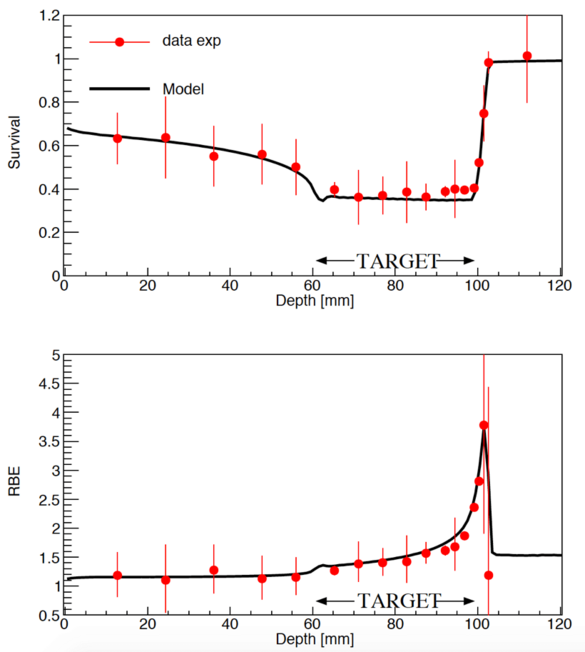3. Advanced Biological Modelling for Hadrontherapy
The current clinical standard worldwide administers proton therapy assuming a constant relative biological effectiveness (RBE) of 1.1, despite extensive evidence of variable RBE in the literature. For heavier ions (e.g. carbon ions), multi-variable dependency of RBE, such as dose, linear energy transfer and tissue type, make practical assumptions clinically implausible. Various biophysical and phenomenological approaches exist, such as the microdosimetric kinetic model (MKM) and the local effect model (LEM). Recent works developed and validated a sophisticated data-driven approach to predicting and handling variable RBE for both proton and novel helium ion beams via coupling with FLUKA Monte Carlo code (MC) containing a detailed description of the beam-line at HIT (Fig. 1). Integration into the FRoG project is underway, in preparation for the upcoming helium ion beam therapy program, as well as our mission to uncover the untapped clinical advantages of therapeutic ion beams through analysis of patient-specific clinical outcome.

Literature:
A. Mairani, T. T. Böhlen, I. Dokic, G. Cabal, S. Brons, and T. Haberer, “Modelling of cell killing due to sparsely ionizing radiation in normoxic and hypoxic conditions and an extension to high LET radiation,” Int. J. Radiat. Biol., 2013.
A. Mairani et al., “The FLUKA Monte Carlo code coupled with the local effect model for biological calculations in carbon ion therapy,” Phys. Med. Biol., vol. 55, pp. 4273–4289, 2010
A. Mairani et al., “Data-driven RBE parameterization for helium ion beams,” Phys. Med. Biol., vol. 61, no. 2, pp. 888–905, 2016
A. Mairani et al., “Biologically optimized helium ion plans: calculation approach and its in vitro validation,” Phys. Med. Biol., vol. 61, no. 11, pp. 4283–4299, 2016.
Dokic et al., “Next generation multi-scale biophysical characterization of high precision cancer particle radiotherapy using clinical proton, helium-, carbon- and oxygen ion beams,” Oncotarget, vol. 7, no. 35, pp. 56676–56689, 2016.
A. Mairani et al., “A phenomenological relative biological effectiveness approach for proton therapy based on an improved description of the mixed radiation field,” Phys. Med. Biol., vol. 62, no. 4, pp. 1378–1395, 2017.
A. Mairani et al., “Optimizing the modified microdosimetric kinetic model input parameters for proton and 4 He ion beam therapy application,” Phys. Med. Biol., vol. 62, no. 11, pp. N244–N256, 2017.
G. Magro et al., “The FLUKA Monte Carlo code coupled with the NIRS approach for clinical dose calculations in carbon ion therapy,” Phys. Med. Biol., vol. 62, no. 9, pp. 3814–3827, 2017.






